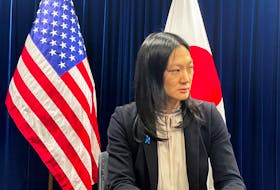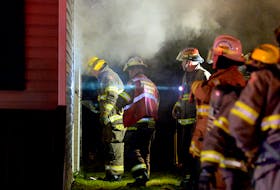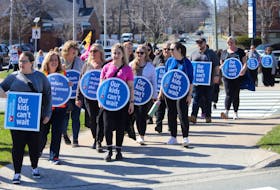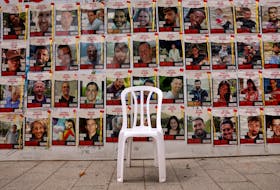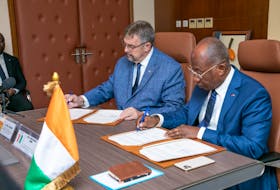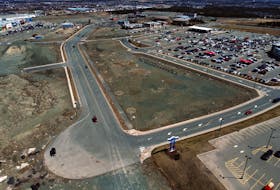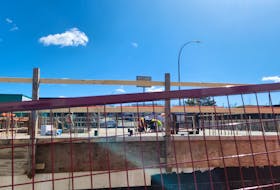Near the Military Road entrance of Bannerman Park in St. John’s on Saturday afternoon, a city crew dismantled a white tent where an hour or so earlier several hundred people had gathered.
Nearby, three teenagers sit on a bench looking at and chatting about the newly-erected sculpture a few feet from them.
It’s exactly what the sculptor intended.
The teenagers look at the bronze Royal Newfoundland Regiment soldier with wonder.
The soldier is wearing his uniform. His cap with the caribou head badge is held in his hand near his hip.
“It’s passing on the torch to the next generation."
Sculptor Morgan MacDonald
He’s missing a piece of his ear — a reminder of the war and the bullet that nicked him as it whizzed past his head.
He’s holding the hand of a smiling young girl, presumably his daughter.
Morgan MacDonald created the sculpture, and he’s still in the park along with those teenagers on the bench, and several others who stand around admiring the monument.
MacDonald hopes the monument encourages passers-by to reflect, but in particular he hopes it encourages young people to ask questions.
“It’s passing on the torch to the next generation,” he said.
He recalls the day the monument was installed — there was a boom truck and workers wearing hard hats and safety vests.
Among them, a young boy was riding his bike.
“(The boy asked), ‘What’s this all about?’ And it’s making that connection to tell that kid on the bike that this a Newfoundland Regiment soldier, and do you know what the Newfoundland Regiment did? This kind of stuff. I think it acts as just another piece to give that reflection to the next generation,” said MacDonald.
Unveiling the monument at the ceremony were benefactor Marty Gregory and Mayor Danny Breen along with plenty of children — great-grandchildren of Sgt. Charlie Parsons, one of the heroic Monchy 10 soldiers, and six students from Beatrix Potter School in London who tend the graves of Newfoundlanders buried at Wandsworth Cemetery.
Those children have picked up the torch to which MacDonald refers in their efforts to learn more about the soldiers whose graves they tend. It’s the sort of inspiration MacDonald hopes the monument will instill in others.
Bronze soldier based on benefactor’s grandfather
For a ceremony in St. John’s, there were quite a number of attendees from Spaniard’s Bay.
That’s because the soldier depicted in the monument was somewhat based on the benefactor’s grandfather, Lance Corporal Matthew Brazil, and many of his descendants now live in Spaniard’s Bay.
Brazil was a Royal Newfoundland Regiment soldier during World War One.
His grandson and Spaniard’s Bay Mayor Paul Brazil said he was “one of the fortunate ones” who answered roll call the next day after the Battle of Beaumont-Hamel.
Paul and benefactor Marty Gregory are first cousins, and Matthew Brazil was their grandfather.
Paul said his grandfather had several injuries during the war — one of them was the bullet wound to his ear that’s depicted in the sculpture.
“You see how it was such a close call, the bullet whizzed past his head — it could have hit him somewhere else in the head and ended his life. Grandfather went to war before he got married and started a family, so should he have not survived the war, well that would be it for all of us – we wouldn’t be in existence,” he said.
Instead, Brazil survived Beaumont-Hamel and Gallipoli, survived what one telegraph described as “gunshot wounds face and leg, severe”, and survived being gassed twice.
He eventually had at least 50 grandchildren, according to Paul’s estimate.
Today, his memory and the memory of so many other soldiers like him, also survive — they’re kept alive in the looks of wonder in teenagers’ eyes as they admire his bronze likeness in the park and kept alive in the questions children might ask when they pass his statue as they play freely in the park.
Twitter: @juanitamercer_

